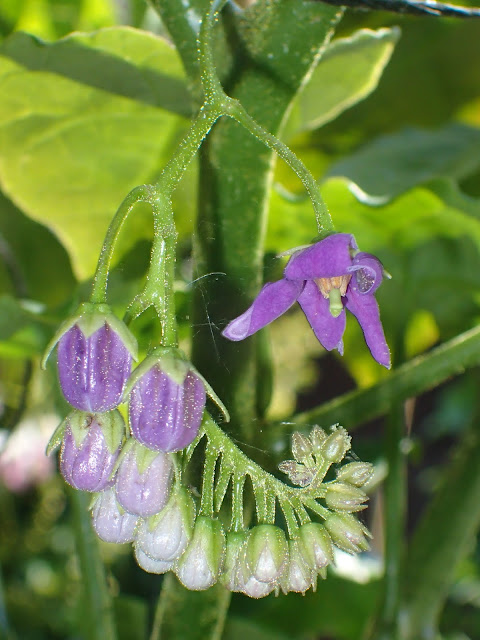On March 2019 I described my experiment with crossing of two half-hardy tamarillo species: Hardy
Tamarillo Cyphomandra
corymbiflora
(female parent) and male Guava
Tamarillo C.
fragrans = C. diploconos (male parent). Now one of my hybrid plants is in flowers, so I am posting the new photos and description of an appearance of the hybrid (in table - comparison with the parents).
There is a table with comparison on various features of parents and the hybrid:
Features
|
hardy tamarillo
(Cyphomandra corymbiflora)
|
hybrid F1
(Cyphomandra corymbiflora x fragrans)
|
guava tamarillo
(Cyphomandra fragrans)
|
Leaf shiness
|
not shiny, mat
|
shiny
|
very shiny
|
Juvenile leaves lobation, size and color
|
entire, large, dark green
|
3(5) lobed (shallowly), very huge, dark green
|
5 lobed (deeply), medium-large, bright green
|
Mature leaf size and colour
|
large, dark green
|
medium-large, light-bright green
|
medium, light- bright green
|
Leaves thicknes
|
leathery, thin
|
leathery, rather thin
|
thick, waxy, rigid
|
Leaves hairless
|
glabrescent
|
almost glabrous
|
glabrous
|
Leaves longevity
|
deciduous
|
?
|
half-evergreen
|
Trunk base thickness
|
not thick,
slender
|
not very thick, rather slender
|
very thick,
conical
|
Time from sowing of seeds to blooming (in my
experience)
|
about 1 year
|
about 0,5 year
|
8 years
|
Blooming time
(at my northern 50°
latitude)
|
from June
|
from July
|
from August
|
Size of plant when has first flowers
|
about 0,5-1m
(= 2-3ft)
|
about 1m (= 3ft)
|
about 2m (= 7ft)
|
Type of inflorescence
|
dichotomous
corymb-like
|
scorpioid raceme (rarely dichotomous)
|
scorpioid raceme (often dichotomous)
|
Young corolla color and shape
|
purple,stellate
|
purple, campanulate-stellate, irregulary opened
|
purple,
funelliform
|
Older corolla color and shape
|
lavender-white, stellate
|
pale lavender, (camanulate-)stellate with a
little twisted petals
|
yellowish,
funelliform
|
Anthers color
|
yellow
|
yellow-purplish
|
purple
|
Stigma appearance
|
small,
inconspicious
|
wide, capitate, large
|
wide, capitate, very large
|
Fruit appearance
|
pale green, dark green stipped, hairy
|
?
|
yellow,
glabrescent
|
Fruit taste and skin texture
|
gentle aromatic, mild, tasty raw, skin soft
|
?
|
very aromatic, acidous, good for preserves, skin
very strong
|
Frost hardiness
|
(-8)-(-10) C degree
(= 14-17 F degree)
|
?
|
- 3 C degree
(= 26 F degree)
|
Drought resistance
|
rather small
|
small
|
very resistant
|
..and the photos:
 |
| The most (about 7 for 10 ones in my experience) of seedlings were chlorotic, not deloped well and died fastly |
 |
| But some seedlings was healthy and green |
 |
| Young plants |
 |
| The hybrid had lobed juvenile leaves (as male parent) |
 |
| Juvenile leaves were usually 3-lobed and huge size |
 |
| Hybrid plant started to blooming after a few months from seed (about half year old) |
 |
| It started to blooming in July, so it blooms later than female parent (C. corymbiflora) and faster than male one (C. fragrans) |
 |
| The stem was interesting maculated |
 |
| .. and the trunk slender like on female parent, not swolen much |
 |
| The flower in first day (purple petals) |
 |
| ... and in the second day (pale lavender) |



























Update on these please, have they made fruit yet?
ReplyDeleteGreetings from Richmond, Virginia USA. My name is Benson and I'm a Horticulturis. What a beautiful plant! Thank you for sharing your work with us.
ReplyDeleteGreat Blog. Please checkout our services field crop seed processing
ReplyDeleteThanks for shaking great informative content.
ReplyDeletecowboy corgi
https://www.rollitup.org/t/pollen-storage.60623/
ReplyDeletemabey u can try to store pollen for later use. some say just drying it with silica gel and store it in the fridge works. other recomend to freez it.